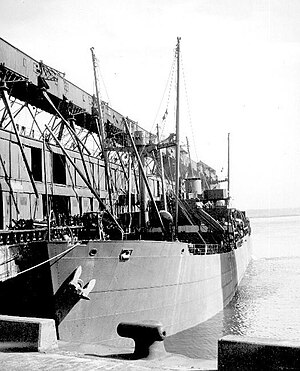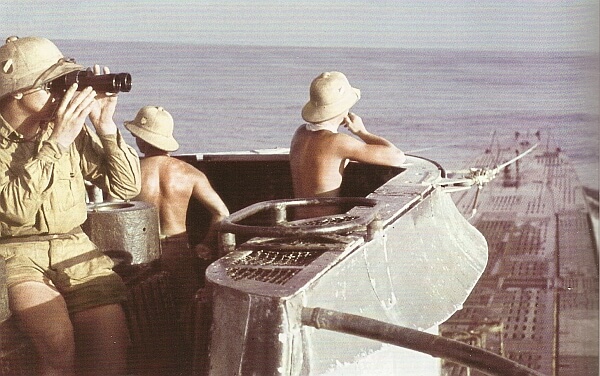
SS Jasper Park 1943 [Wikimedia]
Sailing aboard SS Jasper Park—a 7,129-ton Canadian Merchant Navy vessel launched in 1942—the young sailor remained at his lookout until he was relieved at 4 p.m., whereupon he reported his sighting to the watch officer.
In his superior’s presence that July 5, 1943, he explained the appearance of a vessel on a steady bearing, hull down on the port bow, making intermittent small puffs of smoke. Having witnessed it from the crow’s nest—as clear of a view as he could get—Sharkey was certain a U-boat was on the hunt.
Never would such circumstances be enviable, but with Jasper Park alone some 1,000 kilometres south of Madagascar, not to mention laden with tea and jute, the odds appeared to be stacking up against the ship’s 55 souls.
Word reached Captain William Buchanan of the supposed enemy stalker. The Jasper Park master— a Scotsman living in Vancouver who, according to some, was “long on boorishness and short on good manners”—arrived on the bridge to have a look, but saw nothing. He dismissed the report.
Meanwhile, aboard U-177, 32-year-old Korvettenkapitän Robert Gysae, soon to learn of his recent promotion at some point during the coming hours, had been hunting since 1:40 p.m.

U-177′s second patrol. [U-boote.fr]
Two torpedoes were fired from the surface at a range of about 1,000 metres. One, a dud, sank shortly after leaving the tube. The other hurtled toward its target but missed, instead exploding off the ship’s starboard side.
At least one Canadian sailor on lookout duty witnessed Jasper Park’s close call. As per standard procedure, he too reported the sighting to the watch officer, who subsequently relayed the message to Captain Buchanan.
Once more, the uncorroborated threat fell on deaf ears.
The crew of Jasper Park recorded strike three—by then irrefutable—at 11:05 p.m. the next day, July 6, when two torpedoes found their target. The first hit the starboard side abeam of No. 2 hold; the second struck further aft, abeam of the boiler and engine room. No fewer than four were killed.
Among those in little doubt of being under attack was Second Officer Jim Butterfield. Having been flung about 20 metres across the upper deck, he and fellow crew members quickly realized the scale of the damage.
The torpedoes had broken the ship’s back, and two lifeboats had been “reduced to matchwood by the explosion.” Plus, the starboard Oerlikon 20mm gun on the bridge, together with the 4-inch gun aft, had been rendered useless.
Butterfield, hailing from Vancouver like the shipmaster, was unsurprised when the order came to abandon ship, thankfully made possible by the intact portside lifeboats. The surviving seamen watched Jasper Park sink in 50 minutes.
As the Canadians began pondering their uncertain fate, U-177 surfaced amid hundreds of floating tea chests. The German skipper ordered the lifeboats to come alongside the enemy submarine. There, dreading the prospect of becoming an Allied prisoner of war, Butterfield recalled what happened next.
“[Korvettenkapitän Gysae] asked in halting but adequate English about the ship’s identity, tonnage and her destination,’ reported Butterfield in S.C. Heal’s 1999 book A Great Fleet of Ships: The Canadian Forts & Parks. “He also asked if anyone had been badly injured. By all accounts he was a fine officer.”
Gysae had no intention of taking prisoners aboard U-177—but nor would he dispose of them. The men were free to go, albeit under circumstances where there was no guarantee of survival in a desperate search for dry land.
Luck, however, would be on their side. Following a cold and windy night in hope of finding the African coastline, the crew were eventually sighted and rescued by Australian destroyers Quickmatch and Quiberon.
Canadian-built Park ships, named after national parks across the country, endured countless dangers.
Butterfield, Sharkey, Buchanan, and indeed most sailors from the former Jasper Park, survived the ordeal. The sinking marked the first Park-class merchant vessel lost to enemy action. Unfortunately, it wouldn’t be the last.
Canadian-built Park ships, named after national parks across the country, endured countless dangers as they carried out their vital work transporting Allied war materiel. Four of the ships owned and managed by the 1942-established Park Steamship Company Ltd., a Crown corporation, were sunk by German submarines.
On Feb. 23, 1945—roughly 800 kilometres northwest of Cape Town in South Africa—SS Point Pleasant Park was torpedoed by U-510, promptly killing eight of the 58 men aboard. A ninth succumbed to his wounds in one of the three lifeboats, two of which became separated from the other in a storm.
After several harrowing days, the single group made landfall on Mercury Island near present-day Namibia on March 2. The two remaining lifeboats were rescued by Africana, a South African minesweeper, on March 4.
SS Taber Park and SS Avondale Park—sibling ships chartered to the British Ministry of War Transport and thus operated by British crews at the time of their sinking—were the final two Park-class victims of the U-boat menace.
The former disappeared beneath the waves on March 13, 1945, when a so-called midget submarine launched a torpedo off the English coast with significant loss of life. The latter was claimed by U-2336 on May 7, the last British merchant ship sunk before the German surrender took effect mere hours later.
Some 1,600 Canadian and Newfoundland merchant mariners—or about 13 per cent of the 12,000 who served—were killed in action between 1939 and 1945, a higher rate than any of the Allied armed services during the conflict.
Advertisement






















